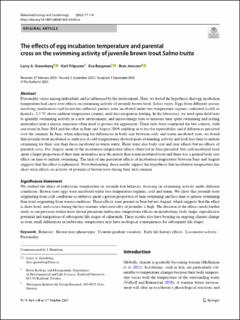| dc.contributor.author | Greenberg, Larry A. | |
| dc.contributor.author | Bergman, Eva | |
| dc.contributor.author | Jonsson, Bror | |
| dc.contributor.author | Filipsson, Kari | |
| dc.date.accessioned | 2023-10-12T09:02:03Z | |
| dc.date.available | 2023-10-12T09:02:03Z | |
| dc.date.created | 2023-10-10T08:57:53Z | |
| dc.date.issued | 2023 | |
| dc.identifier.issn | 0340-5443 | |
| dc.identifier.uri | https://hdl.handle.net/11250/3096005 | |
| dc.description.abstract | temperature had carry-over effects on swimming activity of juvenile brown trout, Salmo trutta. Eggs from different crosses involving anadromous and lacustrine-adfluvial parents were incubated under two temperature regimes, unheated (cold) or heated c. 2.5 °C above ambient temperature (warm), until first exogenous feeding. In the laboratory, we used open-field tests to quantify swimming activity in a new environment, and mirror-image tests to measure time spent swimming and resting motionless near a mirror, measures often used as proxies for aggression. These tests were conducted for two cohorts, with one tested in June 2018 and the other in June and August 2019, enabling us to test for repeatability and if differences persisted over the summer. In June, when adjusting for differences in body size between cold- and warm-incubated trout, we found that juvenile trout incubated as embryos at cold temperatures showed more swimming activity and took less time to initiate swimming for their size than those incubated in warm water. There were also body size and year effects but no effects of parental cross. For August, none of the incubation temperature effects observed in June persisted, but cold-incubated trout spent a larger proportion of their time motionless near the mirror than warm-incubated trout and there was a general body size effect on time to initiate swimming. The lack of any persistent effects of incubation temperature between June and August suggests that the effect is ephemeral. Notwithstanding, these results support the hypothesis that incubation temperature has short-term effects on activity of juvenile of brown trout during their first summer. Behavior · Brown trout phenotypes · Counter-gradient variation · Early life history effects · Locomotor activity · Personality | en_US |
| dc.language.iso | eng | en_US |
| dc.rights | Navngivelse 4.0 Internasjonal | * |
| dc.rights.uri | http://creativecommons.org/licenses/by/4.0/deed.no | * |
| dc.subject | Behavior | en_US |
| dc.subject | Brown trout phenotypes | en_US |
| dc.subject | Counter-gradient variation | en_US |
| dc.subject | Early life history effects | en_US |
| dc.subject | Locomotor activity | en_US |
| dc.subject | Personality | en_US |
| dc.title | The effects of egg incubation temperature and parental cross on the swimming activity of juvenile brown trout Salmo trutta | en_US |
| dc.title.alternative | The effects of egg incubation temperature and parental cross on the swimming activity of juvenile brown trout Salmo trutta | en_US |
| dc.type | Peer reviewed | en_US |
| dc.type | Journal article | en_US |
| dc.description.version | publishedVersion | en_US |
| dc.rights.holder | © 2023 The Authors | en_US |
| dc.subject.nsi | VDP::Zoologiske og botaniske fag: 480 | en_US |
| dc.subject.nsi | VDP::Zoology and botany: 480 | en_US |
| dc.source.volume | 77 | en_US |
| dc.source.journal | Behavioral Ecology and Sociobiology | en_US |
| dc.identifier.doi | 10.1007/s00265-023-03384-w | |
| dc.identifier.cristin | 2183130 | |
| dc.relation.project | Norges forskningsråd: 268005 | en_US |
| dc.source.articlenumber | 114 | en_US |
| cristin.ispublished | true | |
| cristin.fulltext | original | |
| cristin.qualitycode | 2 | |

